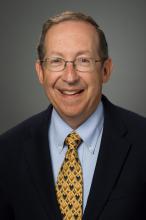, according to two Pediatrics articles highlighted by editor in chief Lewis R. First, MD, MS.
The studies investigated the prevalence and effects of burnout among pediatric residents, and all health care providers, working in intensive care units. They were among those published in 2017 that Dr. First deemed potentially practice changing – ones whose clinical implications may have immediate relevance in your daily work.
“There are a variety of ways to overcome burnout and promote our resiliency that starts with our ability to find joy in caring for children and our lifelong learning” through professional development sessions and academic journals, according to Dr. First, professor and chair of pediatrics at the University of Vermont in Burlington. He also serves as chief of pediatrics at the University of Vermont Children’s Hospital. He spoke at the 2017 annual meeting of the American Academy of Pediatrics and in later interviews.
High prevalence of burnout
The study by Baer et al. found that almost two in five pediatric residents experience burnout, often accompanied by poorer care of patients (Pediatrics. 2017. doi: 10.1542/peds.2016-2163). Using a 7-point Likert scale ranging from “never” to “every day,” 258 residents from 11 different residency programs filled out an anonymous Web-based survey on how often they felt emotional exhaustion (“I feel burnout from my work”) and depersonalization (“I’ve become more callous toward people since I took this job”).
They also answered seven questions about patient care attitudes and behaviors.Of the 258 respondents, 39% had burnout, defined as answering affirmatively to either of the above questions with at least “weekly.” Most of the respondents were female, white, and married or in a long-term relationship without children, but the burnout rates did not vary across gender, race/ethnicity, relationship or parental status, or among different characteristics of the residency program and schedule. Higher burnout rates did occur among those feeling sleep deprived.
Those with burnout also had substantially higher odds of providing lower-quality care. Residents with burnout were seven times more likely to make treatment or medication errors not related to inadequate knowledge or experience, six times more likely to feel guilty about how they had treated a patient, more than four times more likely to report having little emotional reaction to a patient’s death, and four times more likely to discharge a patient earlier to make service more manageable. Burned-out residents had more than nine times greater odds of paying “little attention to the social or personal impact of an illness on a patient,” the study showed.
Burnout symptoms and solutions
Symptoms of potential burnout, Dr. First said in an interview, include emotional exhaustion, feeling a loss of meaning in work, feelings of ineffectiveness, a tendency to view people as objects instead of human beings, increasingly poor communication, and poor interpersonal and clinical skills and behaviors.
Other symptoms include “decreased engagement and enthusiasm, increased cynicism, and a loss of feeling of personal accomplishment or competence at work,” the study’s lead author, Tamara E. Baer, MD, MPH, of Boston Children’s Hospital’s division of adolescent and young adult medicine, said in an interview.Other research also has found burnout linked to doctors’ errors, self-reported negative attitudes toward patients, and less time spent with patients, she said. “Thus physicians should be on the lookout for burnout within themselves as well as in their colleagues and medical trainees.”
Both Dr. Baer and Dr. First noted the importance of organizational leadership in preventing burnout.
The Association of Medical School Pediatric Department Chairs is sharing a toolbox of strategies that they have found effective for reducing burnout and developing wellness among physicians, Dr. First said in the interview.
“Some of those suggestions include personal attention to wellness via good nutrition, exercise, mindfulness for emotional self-regulation, and developing supportive relationships,” he noted. In addition to organizational mindfulness programs and ones that foster work-life integration and social activities, prevention programs should “create wellness and resilience, and a sense of pride and meaning in the work that is being done.”
Drs. First also pointed to ways of addressing triggers of burnout:
- Reduce the burden of bureaucratic tasks.
- Examine how many hours physicians spend at home or work at home.
- Improve efficiency, such as in EHR use.
- Provide individuals time to discuss stressors and ways to resolve them collaboratively with peers and leadership.



